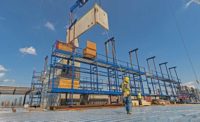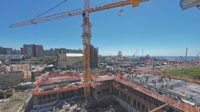Jim White’s long career in construction management, and his long memory, have served his projects well at Oxford Properties Group, and before that, at developers Related Cos. and Brookfield—and at Turner Construction.
His experience especially was critical to implementing an innovative bridgebuilding technique that shaved six months off the schedule of Oxford Group’s $1-billion effort to transform the former St. John’s rail freight terminal on Manhattan’s West Side into the 1.3-million-sq-ft corporate hub that tech giant Google plans to occupy next year.
As Oxford vice president and head of construction for the developer’s U.S. region, White led a construction team that adapted the approach to build a pair of hardened elevator and stair cores to transform the former four-story terminal into a 12-story structure.
But as standard concrete or steel cores weren’t optimal for the structure—which spreads across two city blocks and has to support loads from a steel superstructure and cast-in-place concrete floors—White remembered a segmented bridge-building methodology that a past Brookfield team used a decade ago to construct the platform under the Manhattan West development.
“We wanted to create a vertical core for St. John’s Terminal that was hardened, and realized that this technology could achieve it,” White says.
Oxford assembled virtually the same Manhattan West team that executed the methodology on a horizontal plane, but asked them to shift to a vertical orientation. Structural engineer Entuitive, core contractor Rizzani de Eccher (RDE), steel and core erector Metropolitan Walters and panel manufacturer Jersey Precast delivered for Oxford.
The group created a core of precast concrete panels with matching Lego-style connections that helped to speed up construction, provide greater efficiency in fabrication and ensure more accuracy in erection, team members say. That not only shaved half a year off the construction effort, but also created an optimal workflow for COVID-19 mitigation, according to White.
A cast-in-place core would have required concrete crews to work in close quarters. With precast panels, however, the fabrication team could maintain proper social distance and keep working during the pandemic lockdowns, while erection teams had far fewer people able to socially distance. “It would have been difficult to maintain work on the project had we not used this technology,” White says. Now, construction groups in Boston and Toronto are asking about the methodology for their own vertical applications, he adds.
White, an ENR Newsmaker in 2002 for his work on the reconstruction of the World Financial Center after the Sept. 11 attacks, says the Google building team topped out last fall on the superstructure and core, and now is laser-focused on what he calls an innovative exterior for the new building. “We’re looking forward to talking about it,” he says.






Post a comment to this article
Report Abusive Comment